| 1 | Habu |
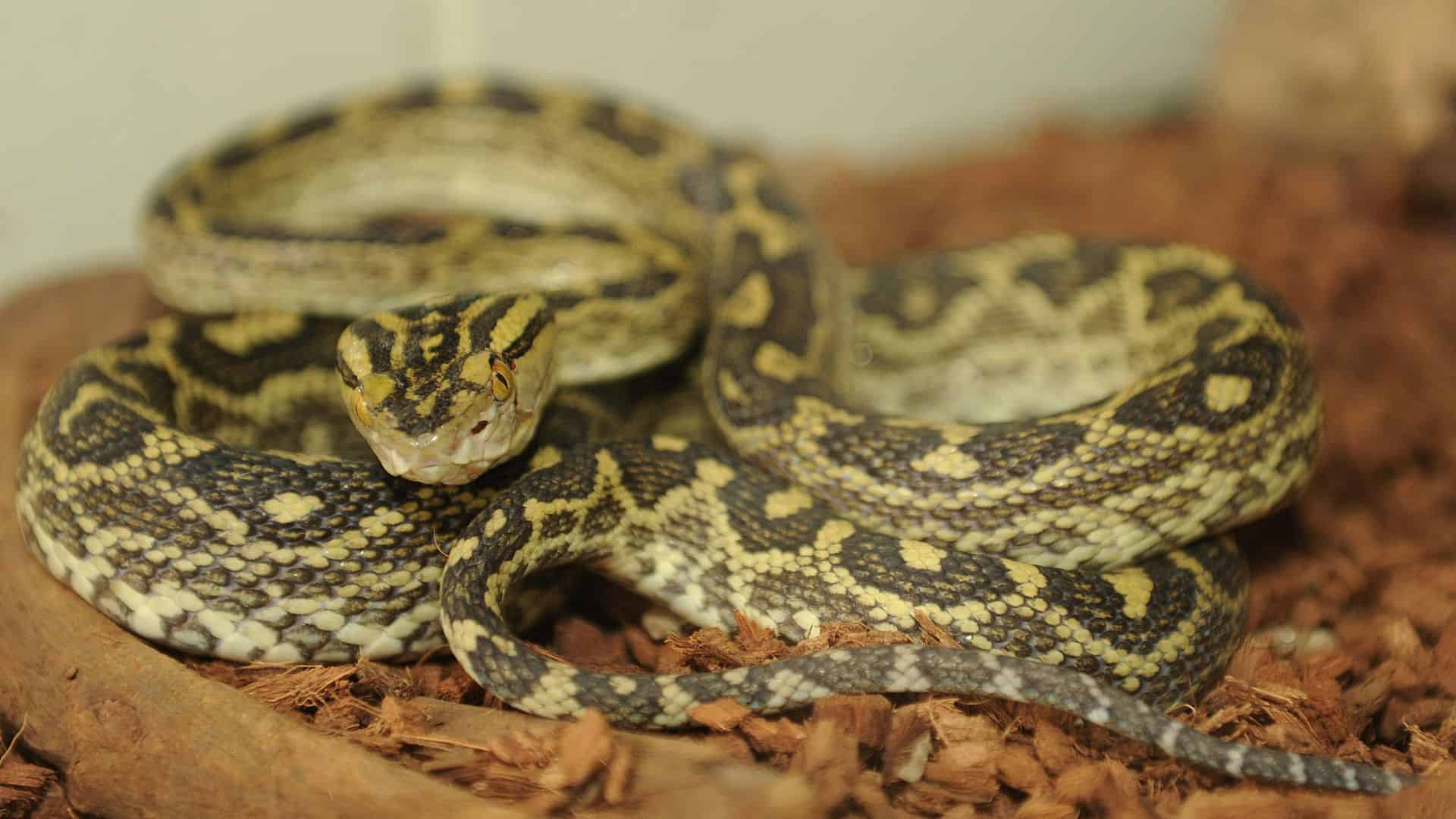
Venomous? Yes.
The further south in Japan you travel, the more snakes you’ll find, and the number one snake hub in all of Japan is the island of Okinawa. This is home to the highly venomous Protobothrops flavoviridis, AKA the habu, a symbol of fear in local villages.
Habus are known for their particularly sharp fangs (with a curved shape), which penetrate deep into the victim. By the maximum record, this is Japan’s longest snake, at a record of 242cm. Habus are common on rock walls, roadsides, riverbanks, and in crop fields alike. They’re known to invade primary schools, sometimes forcing terrified teachers to hold back a mob of curious kids. Many schools on Okinawa stock a repellent called “Habu Knock” – a single spray can kill the snake stone cold dead within 15 minutes.
Habu venom is mostly hemotoxic, destroying red blood cells and wreaking havoc on skin tissue, sometimes leaving permanent injuries. On average, 50 Okinawans are bitten by habus per year, mostly farm workers. An aggressive habu will coil up and face the victim directly with its triangular head. Local wisdom states that you should never move a muscle when the snake enters this position, as it will interpret the slightest twitch as a sign of aggression.
Habus aren’t found on the main Japanese islands of Honshu or Hokkaido, as they only appear on the Ryukyu island chain south of mainland Japan. This includes the large Okinawa and Anami Oshima, but also many smaller, scattered islands between.
| 2 | Japanese ratsnake |
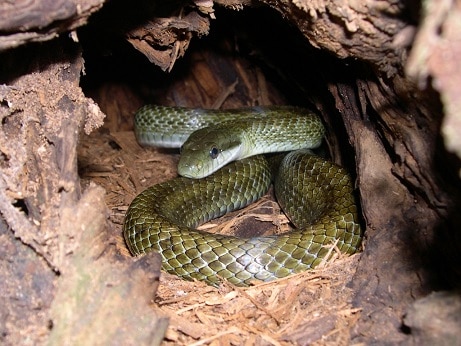
Venomous? No.
The longest snake on the Japanese mainland, AKA the two large islands of Honshu and Hokkaido. Japanese ratsnakes (Elaphe climacophora) begin life at 40cm, grow to 75cm after 15 months, and ultimately end up between 140cm and 200cm, with an all-time record of 230cm. They’re flexible and inhabit numerous habitats, while their diet is equally non-fussy.
Japanese ratsnakes have a particular taste for bird eggs, which they swallow whole and crack open using an extra-jagged spinal column. Like the oriental ratsnake of Thailand, they move quickly through the countryside, and climb trees with ease; they’re an adventurous snake which moves an average of 65 meters per day.
Japanese ratsnakes are also the most heavily worshipped species in Japan. In Ikwada province in southern Japan, there’s a rare albino version, which numbered 1000 back in 1925. Farmers dubbed this rare morph Shirohebi, believing them to be protectors sent by the goddess Benzaiten, particularly as they helpfully cleaned up pesky rats.
By the 1990s, these snowy white ratsnakes had plummeted in number, and a successful breeding program was established. This is located within an immaculately carved shrine, which features water fountains covered with Japanese ratsnake statues, and a gift shop with white ratsnake lucky charms (with glowing red eyes). As of 2005, the snowy white Japanese ratsnakes had fought back and reached 953 in the wild.
| 3 | Mamushi |
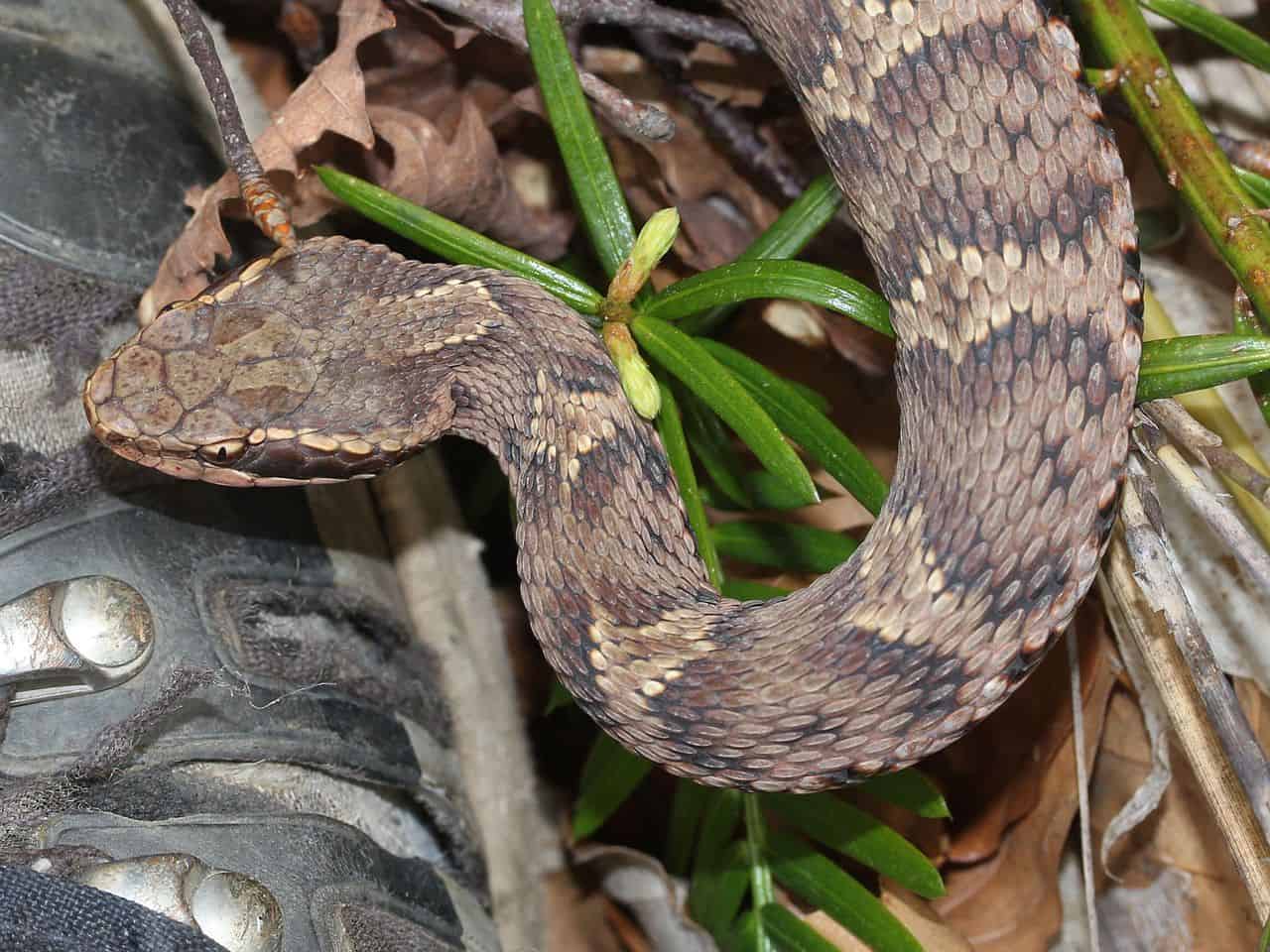
Venomous? Yes.
The most feared snake on mainland Japan. This killer inhabits most of Honshu, including the countryside surrounding Tokyo. They’re less common on colder Hokkaido, but are still found there in smaller numbers. Japanese forest trails are filled with carved wooden signs warning of the dangers of the mamushis lurking nearby.
The mamushi (Gloydius blomhoffii) measures 40-85cm, with a maximum of 91cm, and bites an estimated 3000 Japanese people per year. Its venom is hard to predict, but the worst bites can cause your flesh to liquify. Mamushis specialise in massive cell death, while also boasting a handful of neurotoxins which cause drooling and convulsions. Then there’s hyaluronidase; this venom ingredient dissolves hyaluronic acid in the surrounding skin, to allow the actual deadly toxins easier entry.
One notorious feature is that bites are hard to notice. The mamushi’s fang marks are tiny, which often leads to delayed hospital treatment. Mamushis are quite fussy, and generally stick to leaf litter piles in forests. Consequently, most bites happen on the toes, or on the fingers when woodland foragers bend down to pull up herbs or mushrooms.
Despite the fear they inspire, mamushis have enemies of their own. They’re often hunted by the orange-coloured Japanese weasel, as well as the far larger Japanese four-lined ratsnake (featured below). The mamushi’s own diet is wide-ranging, including mammals, reptiles and amphibians.
| 4 | Black-banded sea krait |
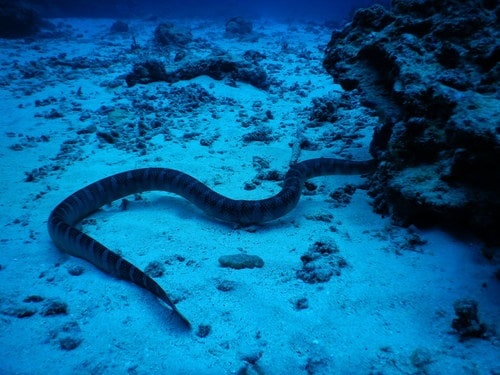
Venomous? Yes.
The signature sea snake of Japan. Black-banded sea kraits (Laticauda semifasciata) measure 70-100cm, with a maximum of 170cm, and have a venom ten times more toxic than the average cobra. They’re a slow-moving (or swimming) species, and stick mainly to reef areas, where they lurk in ambush for fish. In Japan, they’re abundant around the southerly Ryukyu islands, including Okinawa, and are commonly encountered by traditional fishermen in wooden boats.
Sea snakes are plentiful near Australia and Thailand, and there’s several dozen species worldwide. However, Laticauda semifasciata is the most northerly reaching of the lot, inhabiting colder waters – hence why they’re found near Japan.
Black-banded sea kraits have the usual sea snake skills, such as enhanced oxygen absorption into the bloodstream, which allows them to go 6 hours without breathing. They spend much of their time in water, but stray to land to breed and digest food. Stay on a rocky Okinawa beach for long enough, and you could witness this snake wash up in vast numbers.
The black-banded sea krait commonly appears in Japanese cuisine. It’s the main ingredient of irabu-jiru, a traditional soup believed to restore womanhood. Before preparation, the snake meat is dried fully, becoming rock solid. The meat itself is said to taste like tuna (comments are welcome if you’ve tried it…), and to compliment these snake flavours, the soup contains tofu, seaweed, boiled pork feet, and Japanese taro potato.
| 5 | Japanese keelback |
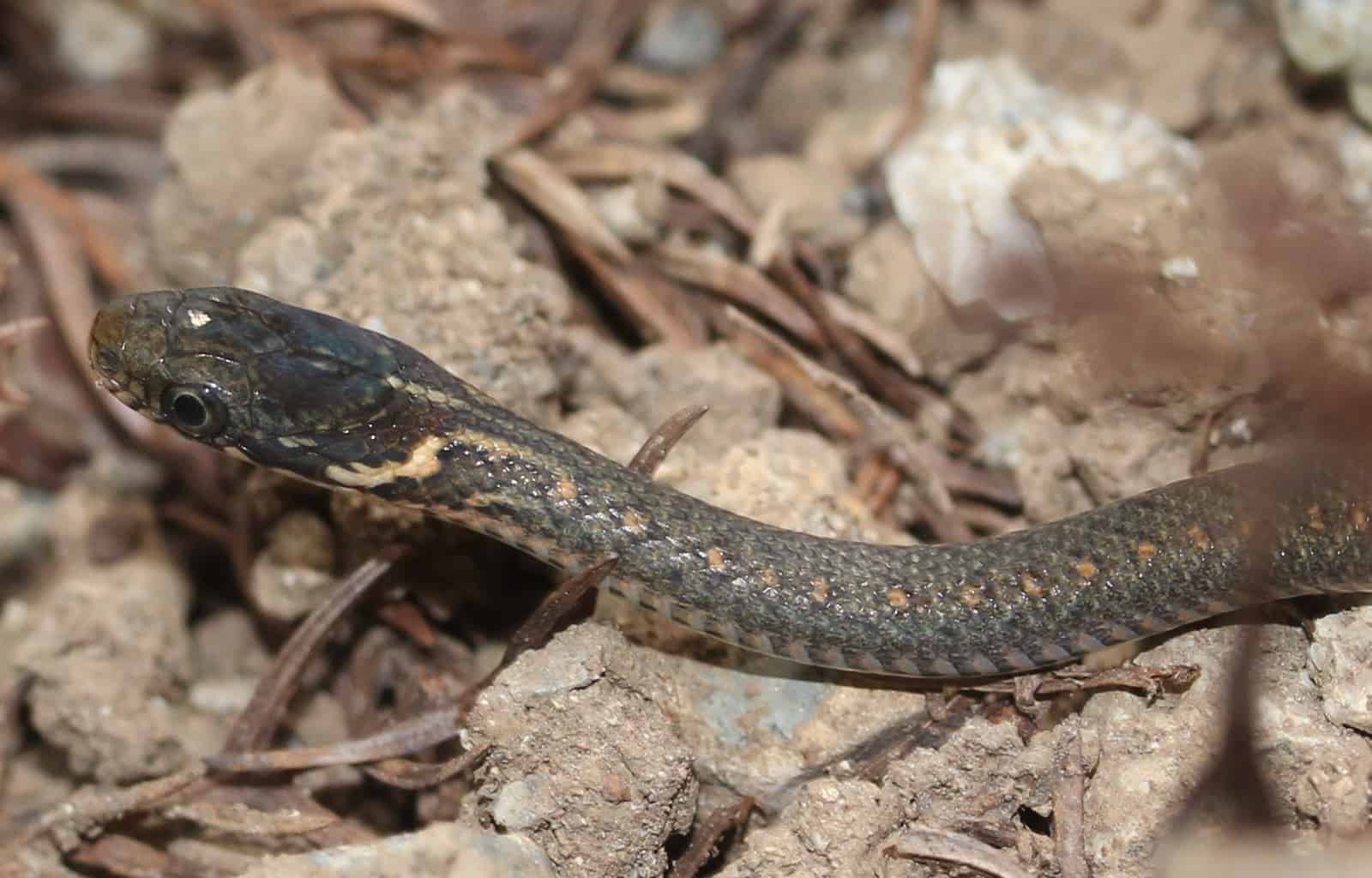
Venomous? No.
The Japanese name for this snake is Hibikari, which means “only live a day”. Whether this means that bite victims only live for a day or the snake itself is unclear. Either way, this species is completely harmless, and is one of mainland Japan’s smallest and most humble snakes.
Japanese keelbacks average at 35-50cm, and mainly eat small, slimy items such as worms, tadpoles, small fish and small frogs. They’re commonly found in cluttered rice fields with farm machinery lying around, but also remote forest paths, such as those leading up to mountain shrines. Their favourite habitats of all are forest areas with a water source nearby. Japanese keelbacks spend time on the ground, but are excellent swimmers. They commonly dive underwater to hunt for fish in the shadowy depths below, sometimes lurking in underwater rock formations.
Japanese keelbacks (Hebius vibakari) are olive to light red in colour. Their bodies have only subtle patterns, but their heads are another story – their mouth area is covered with deeply contrasting jet black lines.
Japanese keelbacks are crepuscular, coming out of their sheltered dens during dawn or dusk – any time the sun is on the horizon. However, they sometimes move during the day when the weather is particularly grim and rainy. This species is small but common, appearing all over the main Japanese island of Honshu, though not Hokkaido to the north. They’re also plentiful in the Korean peninsular. A study tested 34 members of this species and found a maximum length of 55.4cm.
| 6 | Japanese four-lined ratsnake |
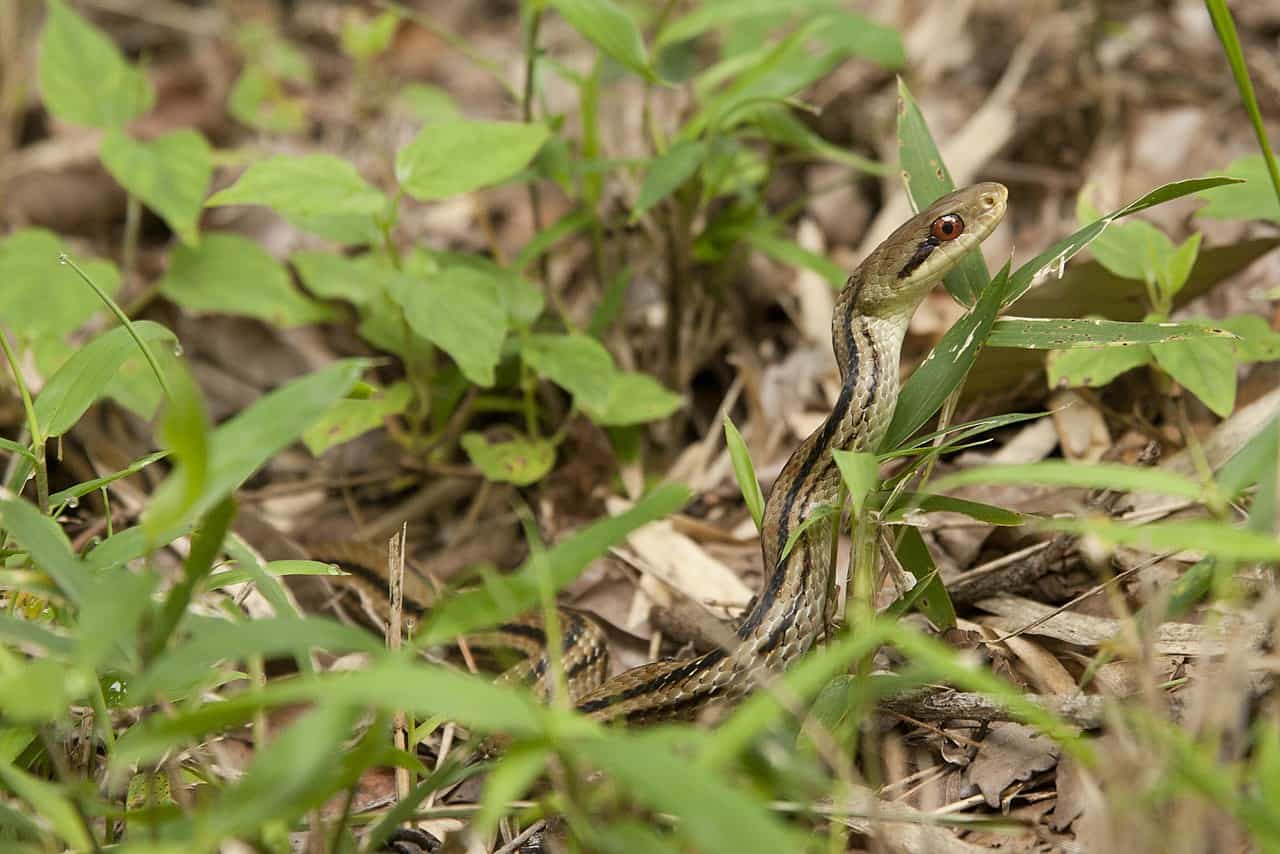
Venomous? No.
A widespread snake in Japan, and a common neighbour of the tiger keelback, particularly in forests and rice fields. Four-lined ratsnakes (Elaphe quadrivirgata) are common both on Honshu and Hokkaido to the north. This is a peaceful snake, with no venom whatsoever, and even their constricting skills are relatively feeble.
Four-lined ratsnakes are simple to recognise when out and about, mainly because of their signature four lines. These are black, contrasting against their olive scales, and stretch in parallel formation down their entire body. Japanese four-lined snakes also have oval pupils, versus round pupils for their close Japanese ratsnake relative (both members of the Elaphe genus).
This Japanese snake has a particularly flexible diet. A study on Yakushima Island found that its main prey was the Okada’s five-lined skink, but a mainland study observed a diet of 96.6% frogs and toads. The main two species were the Japanese tree frog and Japanese gliding frog.
On the small Kinksan island, the four-lined ratsnake almost exclusively eats Tago’s brown frog. Wherever they live, they’re able to adapt to the local prey populations. With the smallest amphibians, the four-lined ratsnake sometimes skips constriction entirely, preferring to grab the frog manually and swallow it alive.
This species is generally smaller than its Japanese ratsnake cousin, but has an especially large variation in size. In frosty Hokkaido, adults are generally less than 80cm, but on islands like Tadanae Island where they can gorge on seabirds and their eggs (yet another dietary variation), this species reaches up to 200cm.
| 7 | Red-banded snake |
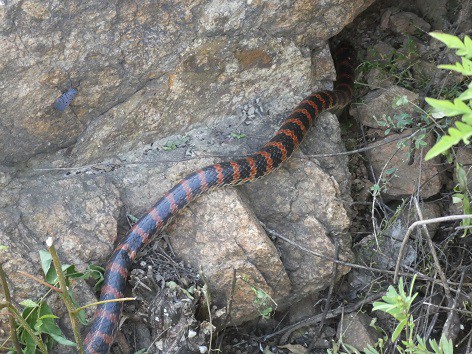
Venomous? Probably not.
The red-banded snake, AKA Lycodon rufozonatus, inhabits a large range in southeast Asia, including Korea and eastern China. However, the subspecies L. r. walli is found only in Japan, on the Ryukyu islands of Yaeyama and Miyako. They’re not found on mainland Japan at all, making them one of the harder native species to find.
Red-banded snakes are a nocturnal species which sometimes inhabits forests, but particularly moist river plains. They’re believed to be non-venomous, as early explorers filed them under “innocuous” in their hastily scribbled logbooks. They usually curl up inside their coils fearfully when confronted, but sometimes do the exact opposite and bite their opponent savagely (albeit non-venomously).
Red-banded snakes average at 50-100cm (record: 130cm), and have a particularly wide diet. This includes birds, reptiles and amphibians alike, and in 2018, they were spotted eating sea turtles for the first time. 2016 saw an epic battle with a black-banded sea krait, which had slithered onto a limestone rock slit by the coast. Black-banded sea kraits are slow moving outside of their watery comfort zones, and the red-banded snake managed to seize and swallow it. But soon after, it regurgitated the now-dead 88cm snake, having bitten off more than it could chew. This is one of the more poorly researched of Japan’s snakes.
| 8 | Tiger keelback |
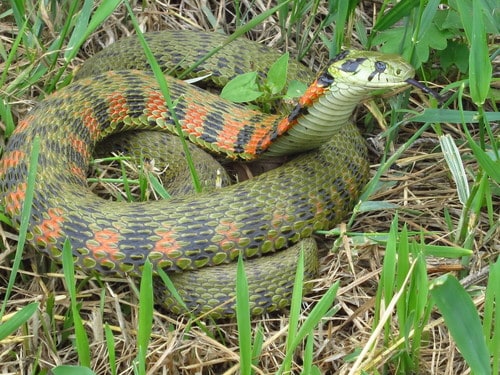
Venomous? Yes.
This potentially deadly serpent occupies most of Japan, skipping Hokkaido to the north, but roaming freely around the main island of Honshu. This venomous creature appears in forests and grassy fields alike, with the main requirement being a source of water like a river or shallow stream.
Tiger keelbacks measure 60-110cm, with an all-time record of 170cm. Their main diet is amphibians, and like the red-necked keelback of Thailand, this snake has the crafty gimmick of storing toad poisons in special glands in its neck. When predators make a clumsy grab for them, they release these toxins in a deadly white froth.
Tiger keelbacks also possess their own venom, which is easily potent enough to a kill human. One study scoured the archives for tiger keelback incidents from 1971 to 2020. 43 bites were discovered, equaling less than one per year. Patients who received antivenom had a 100% recovery rate, but 23% of those who didn’t died. This included two deaths in 2006 and 2020, both elderly people.
Tiger keelback bites are more common in western Japan, as are tiger keelbacks themselves. Fortunately, a dedicated antivenom for this species has been around since 1985. Originally, it was created by injecting venom into rabbits and goats, and collecting the antibodies, but in the 1990s, they switched to horses, as this was more economically efficient.
| 9 | Thsuhima Island pitviper |
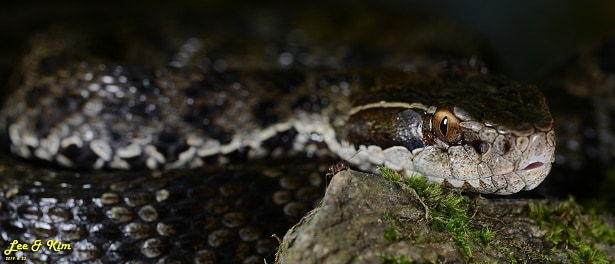
Venomous? Yes.
One of Japan’s deadliest snakes. The Thsuhima Island pitviper (Gloydius tsushimaensis) is a relative of the mamushi, essentially a stranded island version that slowly got angrier and angrier over time. It only became an official species in 1994, and lives solely on the isolated Tsushima Island, part of the southern Ryukyu chain. This island has a human population of 30,000, and consists of 90% pristine forest.
This species is 50-70cm on average, and differs from the mainland mamushi in several ways: fewer red bands on its body, a shorter head, a missing black spot inside the bands, and a salt and pepper pattern on its belly. The Thsuhima Island pitviper is also a faster-moving species.
Likes its mamushi cousin, the Thsuhima Island Pit viper has a toxic venom. You might guess that the venoms would be similar, but a study on victims from 2005-2018 found that severe hypofibrinogenemia is one of the classic symptoms. This is when fibrogenin levels fall below 100mg/dl, sending the risk of fatal bleeding to perilous levels.
The study covered 72 bites, and when the worst patients were given mamushi antivenom, no improvement was seen in the depleted fibrinogen. There was no crossover benefit against the toxins of its cousin. This island mamushi is a unique horror story, with uniquely deadly weapons.
| 10 | Oriental odd-toothed snake |
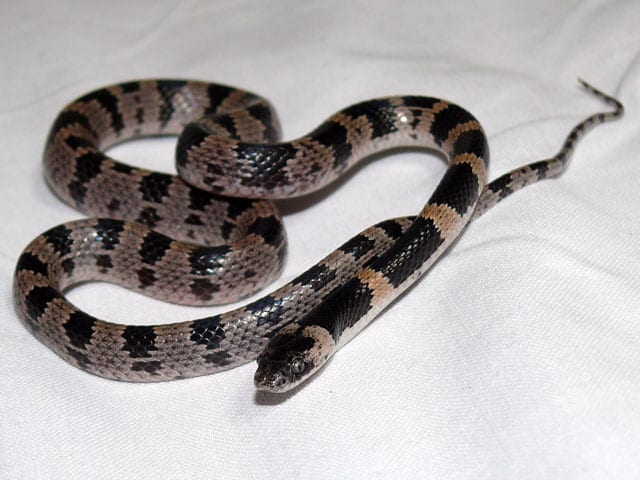
Venomous? No.
One of Japan’s rarest snake species. This forest snake inhabits almost all of Japan, including the main two islands of Honshu and Hokkaido. It appears on many other islands, such as Shikoku, Kyushu, and even Shiashkotan, one of the Kuril islands north of Hokkaido which formed the old ice age land bridge with Russia. Yet across that vast territory, the oriental odd-toothed snake is only rarely encountered.
This is a secretive snake, which averages at 30-70cm. Despite being first discovered in 1880, not much research has been conducted since. We know that it likes to hide under forest mulch, and has a diet consisting of lizards and amphibians. It shares one of its top prey with the Japanese four-lined ratsnake: Okada’s five-lined skink. Other meals on this snake’s menu include the Japanese bullfrog and Japanese grass lizard.
In 2020, an 80 year old Japanese man was ambling round his garden, when he picked up a flower pot. Out from below slithered an oriental odd-toothed snake. The authorities were delighted, as the snake was becoming increasingly rare in Kashiwa province (east of Tokyo). Odd-toothed snakes have barely any encounters with native Japanese people, let alone tourists, but are assumed to be non-venomous.
